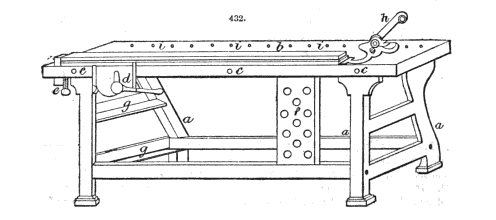When you look at old engravings, there are going to be details that confuse. Perhaps they were drawn incorrectly. Or you just don’t have enough information to interpret the marks on the page.
Several years ago, I wrote about the French benches in the La Forge Royale catalog, which illustrates several benches with wagon vises. The images of the benches show an odd thing hanging down below the benchtops. It’s clearly a stick, but its purpose isn’t discussed in the text of the catalog.
After several years of speculation, we now know what this dangling stick is. It is the handle for the wooden screw that attaches the top and base together. Thanks to a photo from Jameel Abraham, we have this clear cut-answer.
Of course, this answer raises some questions. Does this method of attaching the top and base adequately resist the horizontal forces from the leg vise? If you built a bench like this and attached the top and base with lag screws alone, you’d be sorry. I am sorry.
Perhaps the top and base of this French bench are attached with both the wooden screw and some dowel pins. I guess I’ll never know until I get to take apart one of these benches myself.
— Christopher Schwarz

















